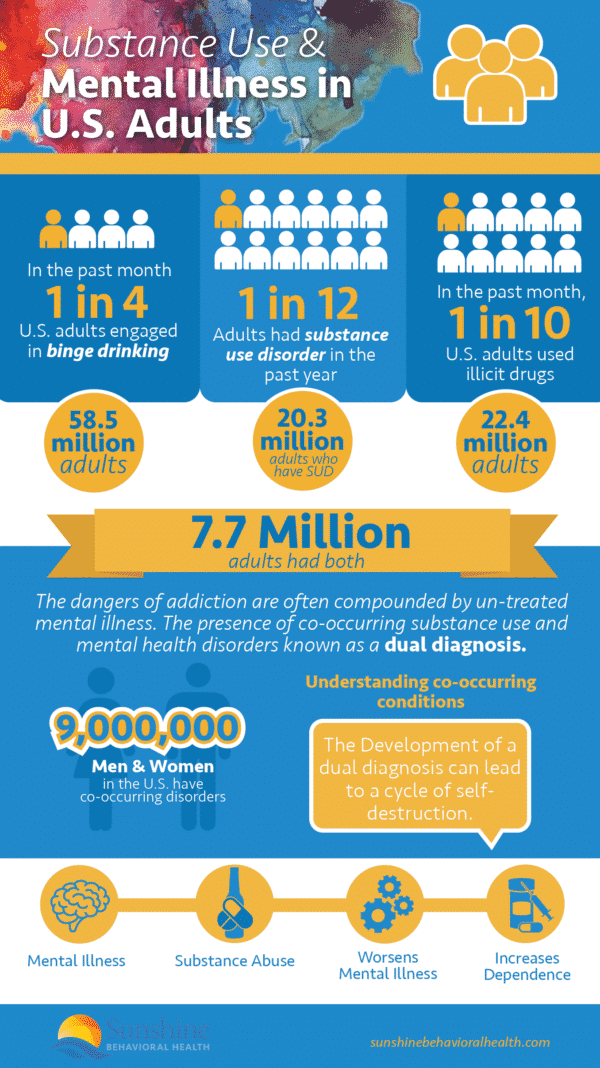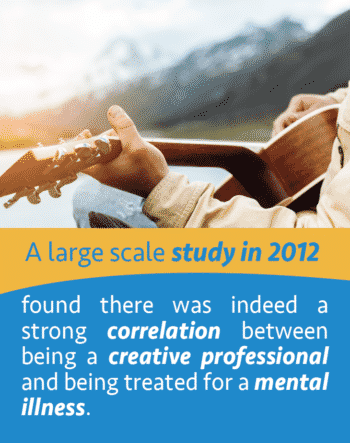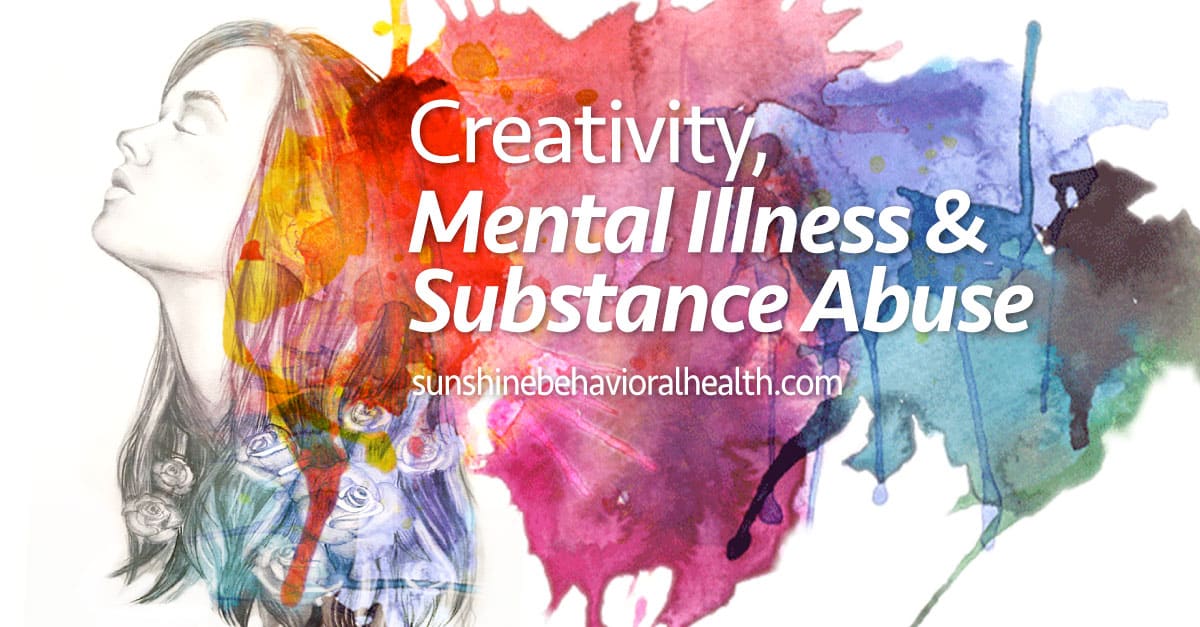Popular culture is saturated with the idea of the tortured artist. The stereotype of the mad genius is so old that it is believed to have originated with Plato; in other words, this concept of art being linked to mental illness, including substance use disorder, is nearly as old as Western Civilization.
But how accurate is this depiction? Is there a causal relationship? Does creativity make a person more susceptible to mental illness and substance use disorder, or are those more predisposed to mental illness and substance use disorder also more creative?
In this article, we’ll take a look at some of the most famed artists, scientists, and thinkers to have exemplified this phenomenon as well as examining how accurate this theory really is. Is there truly a connection between creative genius and mental illness, and if so, how strong is it?
While scientists have been studying the link between mental illness and creativity for years, there are numerous obstacles to conducting a controlled study on the matter. One major barrier to exploring this question is there is no clear-cut way to indicate the level of genius or creativity one person holds.
While there are medical definitions for mental illness and substance use disorders (SUDs) it can be complicated to apply these definitions to historical figures who have never been examined by modern medicine. It’s just as difficult with modern geniuses, as the only perspective we have on their lives is how the media portrays them.
How Is Mental Illness and Substance Use Disorder Defined?
Mental illness is defined by the Mayo Clinic as a mental health issue that leads to signs and symptoms that cause stress frequently and can inhibit a person’s ability to function. There are a wide variety of types of mental illness disorders that can affect a person’s moods, emotions, thoughts, and behaviors.
Some examples of mental illness include anxiety disorders, eating disorders, post-traumatic stress disorder (PTSD), depression, bipolar disorder, schizophrenia, as well as addictive behaviors.
Substance use disorder and SUDs are actually a subset of mental illness as they are covered in the Diagnostic and Statistical Manual of Mental Disorders (DSM-V), widely regarded as the ‘bible’ for diagnosing all mental illnesses in the United States.
Substance use disorder can be defined as using any substance to an excess, that causes it to be detrimental to the user, to society in general, or to both. SUDs refer specifically to drug addiction, for example, alcohol, marijuana, and nicotine are all considered drugs; in addition to illegal substances, as well as controlled substances that have been misused.
This illness can affect a person’s brain and behavior to the point that they are no longer able to control their use of the substance.
Examining the link between creativity, mental illness, and substance use disorder, it is important to note that there is a high rate of overlap between the two conditions. When people have two diagnoses simultaneously, this is called comorbidity.
When comorbidity refers to SUDs and another diagnosis, then the person is said to have a dual diagnosis. Dual diagnosis is so prevalent, that approximately half of the people who experience a mental illness not related to substance use disorder will also experience SUDs, and the opposite is also true. For that reason, it is very important to analyze both when exploring the connection to creativity.

Famous Examples of Geniuses Who Suffered from Mental Illness/Substance Use Disorder
Bipolar and Creativity
As mentioned previously, it can be problematic to comb through history and give diagnoses, but this is necessary for the quest to answer whether there is a connection between creativity and mental illness.
One famous study that has looked into this is in the book Touched with Fire by psychologist Kay Redfield Jamison, who has been diagnosed with bipolar disorder. Believing there is a link between creative genius and bipolar disorder, Jamison combed through historical records of well-known minds throughout history. In an appendix, Jamison named 83 poets alone that she believes to have had bipolar disorder, along with lists of writers, composers, musicians, and artists.
She includes a chapter in her book on the Romantic poet, Lord Byron. Byron provided an especially good example in part because he charted his own moods so fastidiously. Byron’s bipolar disorder is also useful to look further into because there is believed to be a hereditary component to this mental illness, meaning you can consider his family tree as well.
While Jamison’s study is focused on people who experience bipolar disorder, there are some studies that point to there being a connection between creativity and family members of those who have a mental illness. This might help explain Ada Lovelace, daughter to the famed poet Byron, who was a highly creative mathematician, often credited with writing the first computer program. While there is no record of her experiencing any mental health issues, she did use opiates later in her life.
Another person included in Jamison’s book, and one of the most famed exemplars of mental illness and genius going hand in hand is Dutch Post-Impressionist painter Vincent van Gogh. He is often cited by people as an example of a mad genius. However, Jamison herself acknowledges that diagnosing van Gogh is quite controversial, she points to a family history of suicide and mood disorders to back up her claim. Van Gogh’s diagnosis is complicated because it might also be affected by a complex partial seizure disorder.
Some even believe that his death was not suicide, but van Gogh’s attempt to protect a teenager who shot him in the abdomen. However, the fact remains that van Gogh did cut off part of his ear, and he regarded doing so as a creative act, and his life story has made for many case studies considering the link between mental illness and creativity.
ADHD and Creativity
Another great artist who is believed to have potentially suffered from mental illness is Leonardo da Vinci. Recent evidence has pointed to the possibility that da Vinci contended with Attention-Deficit/Hyperactivity Disorder (ADHD).
While ADHD provides barriers to success for anyone, including making it difficult to focus and turning procrastination into the default, there is also reason to find a connection between the illness and da Vinci’s extraordinary abilities.
A brain study by Professor Marco Catani points out that some of the symptoms of ADHD can aid in creativity, such as mind wandering. It is recorded that da Vinci had difficulties completing tasks from a young age, but his endless curiosity was a major driver in achieving his many feats as well as a distraction. Professor Catani hopes that da Vinci’s post-mortem diagnosis might help end some of the stigma surrounding ADHD.
He remarks on how amazing it is that da Vinci considered himself a failure in his own life, and believes that da Vinci’s story perfectly illustrates how there is no connection between low IQ or lack of creativity and ADHD.
Depression and Creativity
Looking for creative minds outside of the arts, one of the greatest (and most creative) political minds this country has ever known is widely acknowledged to have depression. More popularly referred to as melancholy in Abraham Lincoln’s own lifetime, the diagnosis is somewhat less controversial than that of other historical figures because Lincoln referred to the condition in his writings and letters.
Additionally, there is so much evidence in the form of first-hand accounts of people who knew the president well. Lincoln’s depression was so severe that he was believed to have collapsed once, and in January 1841 he sought the care of Dr. Anson Henry, saying he was “necessary to my existence.” Despite facing this debilitating illness, Lincoln nevertheless rose to the occasion of leading the United States through one of its most challenging moments, oftentimes meeting impossible situations with creative solutions.
Part of the reason why it is necessary to look back to history for examples of mental illness is that there is such a stigma surrounding the issue that those who face it in today’s society oftentimes choose not to disclose their condition if given the choice.
SUDs are not always such an easy condition to hide, and many in recovery do choose to share their stories. As a result, there is no lack of examples of SUDs amongst modern-day creatives. In particular, those who have achieved great fame in music and acting are almost treated as synonymous with having a substance use disorder issue. Singer Janis Joplin is one of several musicians to die of substance use disorder at age 27 after a meteoric career.
There is even a scientific study examining the link between creativity and SUDs with her contemporary Jim Morrison, lead singer of the Doors, who also died from an overdose at age 27. Offering a much happier story, one of recovery, is actor Robert Downey Jr., who began using drugs before he was even a teenager. During the 1990s and early 2000s, his name became linked with drug abuse after several arrests that even led to him spending time in prison. In 2002 he declared himself recovered, and his career has taken off even stronger than it was before.
The struggle with mental health issues is not isolated to those who have left a mark in history, either. Many famous millennials have reported struggling with mental illness, including Justin Bieber and Selena Gomez.
Is There a Conclusive Connection Between Mental Illness and Creativity?

The first scientific study to explore this question was conducted in 1931. The Lang-Eichbaum study interviewed over 800 famous geniuses of the day. Of these, a vast majority reported experiencing some mental health issues.
There have been mixed reports from studies since. One of the most oft-cited studies is that carried out by Kay Redfield Jamison. It is important however to note that this looks only at mood disorders, focusing primarily on bipolar disorder, and does not consider other mental illnesses, nor SUDs in any detail, but it does acknowledge the high comorbidity between mood disorders and substance use disorder.
One of the strongest studies in support of there being a connection comes from Sweden. A large-scale study there in 2012 found that there was indeed a strong correlation between being a creative professional and being treated for a mental illness.
The authors of the study were able to make it so large scale by making use of the Swedish Registry. In particular, they found a very strong connection between writing and schizophrenia. The illnesses which the study’s authors examined included: ADHD, anxiety disorders, alcohol abuse, drug abuse, anorexia nervosa, autism, bipolar disorder, unipolar depression, schizoaffective disorder, schizophrenia, and completed suicide.
Another 2012 study that points to a strong link comes from Iceland.
This study examined whether there was a correlation between having a creative profession or being a member of an art society with having the genetic markers that predisposed someone to have bipolar disorder or schizophrenia. The study found that those in creative professions were 25% more likely to have those markers than the control group.
There is no lack of those who take issue with these findings. In fact, it seems that the long list of historical geniuses with mental illnesses is dwarfed by the large numbers throughout history who have shown no signs of mental illness, from William Shakespeare to Jane Austen.
Rothenberg interviewed 45 Nobel laureates and said he could find no sign of mental illness in any of them. He concluded that a large part of the confusion comes from poor definitions of creativity and that while so many who are mentally ill are attracted to creative professions, it does not follow that they are in fact more creative.
So strong is the link between creativity and mental illness, that many experts have begun to incorporate art therapy in their treatment of such cases. Art therapy is a way to allow one struggling with mental and emotional illness to express themselves freely.
It is thought that by giving one the opportunity to use art to show how they are feeling, the potential stigma and concern over talking about emotional and mental struggles is eliminated. Additionally, for those who are struggling with mental health concerns, having the chance to use art offers the chance to enjoy sharper focus, which may be missing in other forms of communication.
Indeed, it is important to remember that there is no definitive link either way between creativity causing mental illness, nor mental illness causing creativity. And while mental illness can give a person a unique perspective it can also stand in the way of achievement, and if untreated can lead to devastating consequences.
If you are considering going into a creative profession, keep in mind is that there is no prerequisite for having a mental illness in order to find success, but many with mental illnesses have thrived within creative professions. It’s also important to note that with SUDs the consequences of not treating the illness are especially severe, and while there are some signs of SUDs being linked to higher rates of creativity, that should never be confused with achieving success in the creative fields.
While the link between creative genius and mental health issues, the large number of those both throughout history and creative celebrities today certainly points to a connection. Did Selena Gomez develop anxiety and depression as a result of her career, or did she embrace her career as a way to cope with her emotional health issues? Did da Vinci create world-renowned art because of mental illness, or was he using his art as a type of art therapy?
No matter which comes first, there are many treatment options for those that struggle with mental illness that use art therapy as a way to help heal these conditions and make life worth living.
Celebrities, Mental Health and Substance Use Disorder: Dancing with The Devil
Demi Lovato, 28, is one such star who has suffered from mental health disorders and addiction. In her new documentary, “Dancing with the Devil,” which contains a warning of potentially triggering aspects, Lovato details how sexual assault led her to become bulimic to the point that she was throwing up blood. This, and acting out, caused doctors to diagnose her with bipolar disorder, which she says, gave her a reason for her actions. These days, she’s sure she has been misdiagnosed, although she remains an advocate for mental health.
After being clean for six years, Lovato suffered a nearly fatal overdose of fentanyl-laced heroin and still struggles with the after-effects today. Found blue and naked, she suffered three strokes, organ failure, and a heart attack. Again, Lovato was struggling with having been sexually assaulted, this time by her drug dealer.
Sources
Medical disclaimer:
Sunshine Behavioral Health strives to help people who are facing substance abuse, addiction, mental health disorders, or a combination of these conditions. It does this by providing compassionate care and evidence-based content that addresses health, treatment, and recovery.
Licensed medical professionals review material we publish on our site. The material is not a substitute for qualified medical diagnoses, treatment, or advice. It should not be used to replace the suggestions of your personal physician or other health care professionals.







